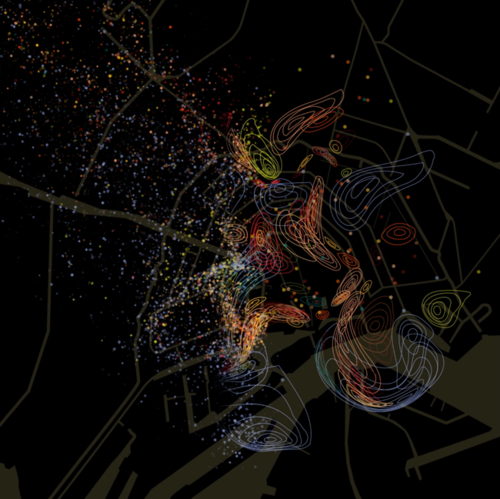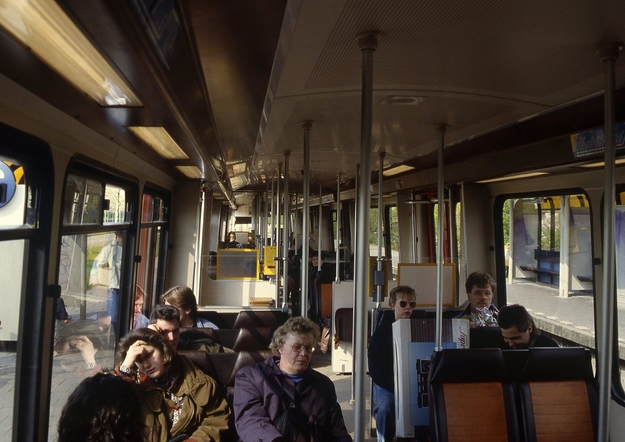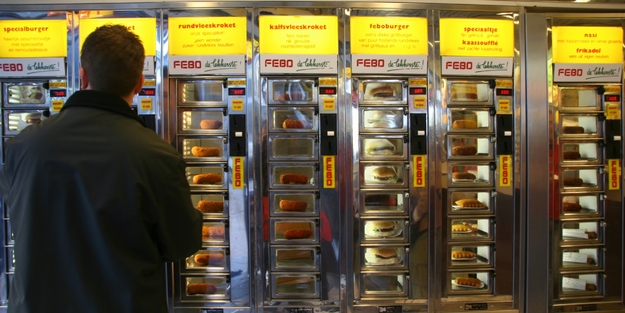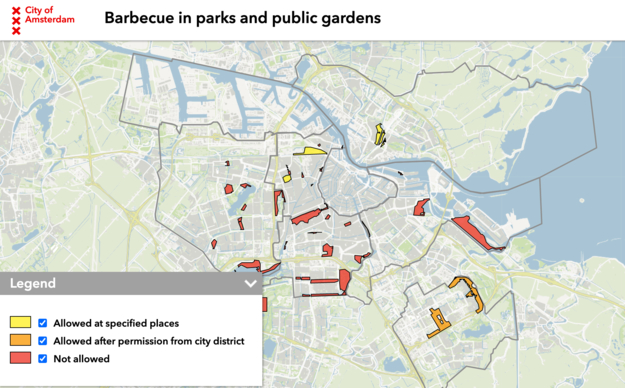The smell is so strong that it may as well be a chemical weaponry, you think to yourself. Actually never mind that, the perfume was in fact their body odor, and the powdery smell of deodorant adds to the pungent cocktail rather than conceal it. In the metro, we do all that we can to avoid eye contact with strangers— some of us look outside, some unwind a spool of earphones, some dig into their purse for their phone or god-knows-what, pretending to be busy one way or another, and if even that is not an option some close their eyes but one can tell when their face is too composed for them to be actually sleeping. Yet despite our efforts to keep others outside our bubbles and us theirs, smells intrude our nostrils and emanate from our bodies.
In his case study "Offensive Bodies", Hyde examines a 1992 US court decision to forbid a homeless person from entering a New Jersey public library because of his body odor. This institutional decision makes three striking implications— the way in which control and expulsion of smell in the city entails an agenda against the society's minority as is most often the case with any form of capsularization (more will be discussed about this concept); a shift in the cultural standard and the degree of agency over, thus the offense that the others have the right to take with regards to smell and personal hygiene; that if the removal of the smell is beyond a person's realistic capability, that then somehow "justifies" "the removal of persons themselves" (Drobnick).
The Capsular City
Many metaphors have been posited for the strange urban environment in which we live. On the one hand, cities are the hubs of interactions between people, ideas, objects, so much so that they often wear us down. On the other hand, cities are oceans that separate individuals in their own islands, in which interaction —in the most genuine, human sense that one can imagine and idealize— is absent. For some people, the two aspects are intrinsically related. De Cauter tells us that citizens form shells around themselves to protect themselves against the rushing torrent of efficiency, information and activities specific to the urban context. And by reducing the friction resulting from the clashing spacetimes of the individual and the city, the capsules encourage further acceleration. In a perpetual quarantine, our activities are characterized by moving from one cocoon to another— from our homes, to our vehicles, to our offices. Returning home, we dive into the blue screens of our devices and into our personal "social" media rabbit holes. In these recent months of the pandemic —where the moral implication of containing one's emanation has become even stronger—, we had a particularly dawning realization of how isolated we are from one another in our beliefs and world views, even more so than in our geographic locations.
...And Smells that Escape
But it is when we are sitting in the metro, suddenly hit by an overpowering smell of another, we feel that our capsules may not be so impermeable after all. We are compelled to look up, our instinct telling us to locate the source of the smell, whereupon our eyes meet those of the other. Perfume is a capsule containing smell— but its very intended purpose is so that the smell breaks out of its capsule and into that of the user and others surrounding them, reacting with the chemistry of one body then being inhaled and becoming a part of another.
However, it is not as though such evasion of smell is welcomed. In addition to removing individuals from "public" spaces such as one aforementioned, scent-free zones dictate that people do not wear perfumes, in some cases, even abstain from scented bath products. The National Foundation of the Chemically Hypersensitive, based in California with thousands of members, demanded that designated “fragrance-free zones” be required in all restaurants and state-owned buildings, some arguing that chemical hypersensitivity ought to be recognized as a disability and that those who have it should be protected under the law (Damian & Damian). On the other hand, shops, restaurants, supermarkets and offices often perfume their spaces with specific smells, effectively demarcating their physical and cultural territories into designated capsules. Expensive clothes brands imprint their signature scents onto the visitors' memory, bakeries ventilate the smell of freshly baked bread, making it irresistible for passers-by, and companies use citrusy room fresheners at different times of the day to improve employee efficiency (Damian & Damian). However, as much as they create olfactory enclaves, environmental fragrances break into individuals' private capsules. Because smelling is involuntary yet so affective, such can be seen as depriving individuals of free will. Thus when neurobiologist Susan Schiffman conducted a series of research to develop scents that can be vented into the New York City subway and reduce aggression, the Citizen Commission on Human Rights responded with concern and prevented smell sedation from becoming a reality (Damian & Damian).
Deodorization is the Ultimate Agenda of the Modern City
Another example of capsularization of smell is most of urban architecture itself. El-Khoury describes the modernist urban infrastructure as being obsessed with the idea of "coating", whether of plastered walls, bathrooms with glazed tiles or cemented pavements, conveying a fiction of olfactory silence through their visual impregnability and sterile whiteness. Some institutions pursue perverse ideal of purity more than others, particularly those with epistemic authority such as museums and libraries. Through deliberate efforts to decolor and deodorize, such institutions put up a pretense of being a Modest Witness (Haraway), concealing their subjective perspectives and political agendas under the fiction of absolute truth and objectivity. Returning to the case of New Jersey library, this process of deodorization entails active evictions of individuals whose very existence challenges the justification of oppression at a societal level. The idea of a "public" space is a fiction so long as the space is demarcated within a capsule that excludes as much as it includes. And yet, this poignant case demonstrates the subversive potential —and threat— that smell poses. Noticing a homeless person in the library, one may simply choose to look away and fixate on the book that they were reading. To not smell them, is much more difficult.
"Even in the city of the grid and the skyscraper, designed to be self-ventilating and supposed to have eliminated the vague, smell persists. There should be no time in New York for reverie, nothing to slow the efficient movement of people, and yet odors rise from cracks and vents, from basement kitchens and laundries, and drift round corners from street markers and bakeries. Moving across the ruled lines of the grid, you breathe: air spirals up the nose, over the folds of the brain and down into the fractal folds of the lungs." (Margolies)
Smells spill all the time, everywhere.
"All kinds of cargo were transported, cocoa beans, jute, gum, currants, raisins, peanuts, ginger and barrels of sherry and beer. We had a special dispensation to store goods on pallets and under sealed tarps on the Prins Hendrikkade and on the quay on the Binnenkant. We sometimes needed a hundred tarps a week. Occasionally loads were placed on the ships as deck load, because there were no warehouses on the piers. And yes, of course sometimes things got stolen from the piers, we did have a guard, but he was always drunk. Like the time we had peanuts under the tarps, and a couple of little boys had wriggled underneath them. There was a trail of peanuts from the Binnenkant to the Nieuwmarkt. For a while, Welter transported many barrels from the Amstel brewery on the Binnenkant. Especially in the beginning this came with damage: inexplicable holes in the barrels where the skipper just had to hold his glass under, otherwise all that previous beer would be lost. When Amstel set the new rule that there was also a keg for the skippers with the cargo, the damage quickly vanished." (Dekker et al.)

Smells as Practices of Resistance
Some quip smell as "the sense of the postmodern" while sight is "modernist sense par excellence" (Graham). Unlike sight that discriminates, divides and orders reality into categories, smell is hard to localize or capture; it permeates capsules, embraces the smellers into itself and becomes part of them, and most of all, changes continually.
So the next time you catch a whiff of dog dropping in Flevopark, the bouquet of weed and beer in the Centraal, chocolate winds blowing from the factories in Zaandam, the waft of the person sitting next to you in the metro, or the smoking scent of döner from a stand in Dappermarkt, smell them as they are the evidences of the everyday resistances (Certeau) that each and every agent in the city produces, constantly evading the capsules surrounding them.
References
Cauter, Lieven de. “The Capsule and the Network.” The Capsular Civilization: On the City in the Age of Fear, by Lieven de Cauter, NAi Publishers, 2004, pp. 77–89.
Certeau, Michel de. The Practice of Everyday Life. Trans. Steven Rendall. Berkeley: University of California, 1984.
Damian, Peter & Kate Damian. “Environmental Fragrancing.” Smell Culture Reader. Oxford etc.: Berg, 2006.
Dekker, Titus (ed). Oosterdok: Stories about an Amsterdam Harbour. WalburgPers.: 2020.
Drobnick, Jim (ed). The Smell Culture Reader. Oxford etc.: Berg, 2006.
Graham, Mark. “Queer Smells: Fragrances of Late Capitalism or Scents of Subversion?” Smell Culture Reader. Oxford etc.: Berg, 2006.
Haraway, Donna J. Modest-Witness@Second-Millennium.FemaleMan-Meets-OncoMouse. Routledge, 1997.
Hyde, Alan. “Offensive Bodies.” Smell Culture Reader. Oxford etc.: Berg, 2006.
Margolies, Elena. “Vagueness Gridlocked.” Smell Culture Reader. Oxford etc.: Berg, 2006.



